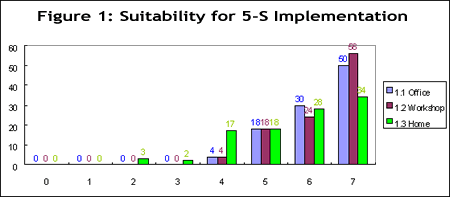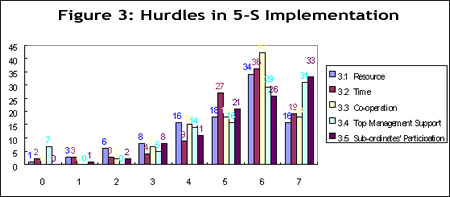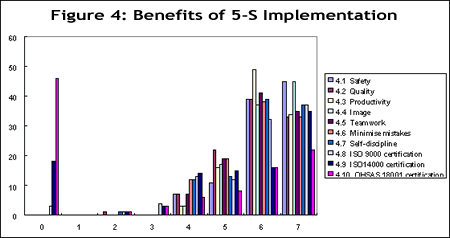 |
TQM and Change Management via 5-S
By Prof. Sam K. M. Ho
Introduction
The 5-S practice is a technique used to establish
and maintain quality environment in an organisation. The name stands for
five Japanese words: Seiri, Seiton, Seiso, Seiketsu and Shitsuke [Osada,
1991]. The English equivalents, their meanings and typical examples are
shown in the following table:
| Japanese |
English |
Meaning |
Typical Examples (out of 50) |
| Seiri |
Structurise |
Organisation |
Throw away rubbish or return to store |
| Seiton |
Systemise |
Neatness |
30-second retrieval of document |
| Seiso |
Sanitise |
Cleaning |
Individual cleaning responsibility |
| Seiketsu |
Standardise |
Standardisation |
Transparency of storage |
| Shitsuke |
Self-discipline |
Discipline |
Do 5-S daily |
The technique has been practised in Japan for a long
time. Most Japanese 5-S practitioners consider the 5-S useful not just
for improving their physical environment but for improving their thinking
processes as well. Apparently the 5-S can help in all walks of life. Many
of the everyday problems could be solved through adoption of this practice.
Management
of Change
There is an old saying: "the only constant is change". If change
is part of our daily life, how can we drive it under our control rather
than being driven off by it? Change in organisation would, in the long
run, lead to change in the organisational culture. A typical example is
the learning organisation, where people are excited in trying out new
ideas and recognise that failure is an important part of success. Let
us take a step back to look at the traditional strategic change process
which can broadly be summarised by five key steps [Ho, 1999]:
Vision ==> Mission ==> Behaviour ==> Action ==> Culture
A new paradigm is:
Action ==> Behaviour ==> Mission ==> Vision ==> Culture
In fact, the first step is nothing new. Peters and Waterman [1982],
have already found out from over 46 successful firms that most of them
choose 'action' as step number one in their pursuit towards excellence.
The new idea here is that action leads to behaviour change of the employees.
This arises from the learning process, and as Reg Raven [1983] said: "There
is no learning without action and no action without learning."
If learning has been taken successfully, the organisational behaviour
will be lifted to a dynamic and challenge-seeking level. This will influence
the top management in defining their mission. By then they are confident
that the mission, spin off from the better organisation behaviour, will
take off once it is announced. The chief executive will then be in a position
to develop the corporate vision which will take the organisation through
to world class against competition. Built on firm foundations, the new
vision will establish a new culture within the organisation. One best
known example of this new culture is 'Kaizen', the Japanese word for continuous
improvement. Being action oriented, 5-S is a powerful quality tool for
everyone to get involved in the improvement process. Therefore, it is
a very effective way to implement the new management paradigm.
Is 5-S Practice
Applicable to the Western World?
Research by Ho [1995] has shown that the western world seldom recognises
the significance of the 5-S practice although there are indications that
some companies have included some aspects of the 5-S in their routines
without being aware of its existence as a formalised technique. There
are many examples of successful implementation of some principles of the
5-S, especially in the service sector organisations, such as fast-food
restaurants, supermarkets, hotels, libraries, and leisure centres. The
difference between the Japanese and western approach lies mostly in the
degree of employee involvement. By formalising the technique, the Japanese
established the framework which enabled them to successfully convey the
message across the organisation, achieve total participation and systematically
implement the practice. The 5-S has become the way of doing businesses,
not only to impress the customers but to establish effective quality processes
as prerequisites for good products and services.
The 5-S Practice
in Detail
In order to be able to comment whether 5-S practice is useful, the proprietary
5-S Audit Worksheet developed by Ho [1995] is exhibited below. Following
the rule of TQM (i.e., KISS – Keep It Short and Simple), the check-points
are mostly self-explanatory:-
| 5S |
What © Prof. Sam Ho –
samho@hkbu.edu.hk |
Where |
How |
Who |
When |
| S-1 Stucturise |
| 1.1 |
Throw away/return things which are not needed |
|
|
|
|
| 1.2 |
Paperless and Re-cycle Bins for papers, bottles,
etc. |
|
|
|
|
| 1.3 |
“Needed things” stored: low, medium
& high usage |
|
|
|
|
| 1.4 |
Personal belongings kept to the minimum |
|
|
|
|
| 1.5 |
Treat defects, leakage, breakage and their causes |
|
|
|
|
| 1.6 |
One-is-best #1:Daily “Things-to-do”
List |
|
|
|
|
| 1.7 |
One-is-best #2: one set of tools/stationery/1-page
form |
|
|
|
|
| 1.8 |
One-is-best #3:one hour meeting |
|
|
|
|
| 1.9 |
One-is-best #4: one stop service for customer |
|
|
|
|
| 1.10 |
One-is-best #5: one location file (e.g. LAN server) |
|
|
|
|
| S-2 Systemise |
| 2.1 |
Everything has a clearly designated name &
place |
|
|
|
|
| 2.2 |
Every place should have a ‘responsible person’
label |
|
|
|
|
| 2.3 |
Eliminate unnecessary covers and locks |
|
|
|
|
| 2.4 |
Functional placement for leaflets, tools and material
|
|
|
|
|
| 2.5 |
Filing standards and control master list |
|
|
|
|
| 2.6 |
First in, first out arrangement |
|
|
|
|
| 2.7 |
Zoning and placement marks |
|
|
|
|
| 2.8 |
Neat notice boards (also remove obsolete notices)
|
|
|
|
|
| 2.9 |
Easy-to-read notices (including zoning) |
|
|
|
|
| 2.10 |
30-second retrieval of tools, document & parts |
|
|
|
|
| S-3: Sanitise |
| 3.1 |
Individual cleaning responsibility assigned |
|
|
|
|
| 3.2 |
Make cleaning and inspection easier |
|
|
|
|
| 3.3 |
Clean even the places most people do not notice |
|
|
|
|
| 3.4 |
Cleaning inspections and correct minor problems
|
|
|
|
|
| 3.5 |
Regular sparkling cleaning campaigns |
|
|
|
|
| S-4: Standardise |
| 4.1 |
Transparency (e.g. glass covers for see-through)
|
|
|
|
|
| 4.2 |
Straight line and right-angle arrangements |
|
|
|
|
| 4.3 |
'Danger' warning signs and marks |
|
|
|
|
| 4.4 |
Fire extinguisher and 'Exit' signs and safety device |
|
|
|
|
| 4.5 |
Work instructions and ‘passed’ labels
|
|
|
|
|
| 4.6 |
Electrical wiring neatness and switch labels |
|
|
|
|
| 4.7 |
Energy Preservation – Aircon temp. mark/switch
|
|
|
|
|
| 4.8 |
Colour-coded gangways/ pipes and directional marks |
|
|
|
|
| 4.9 |
Colour coding -- paper, files, containers, etc.
|
|
|
|
|
| 4.10 |
Responsibility labels on floor plan or at site
|
|
|
|
|
| 4.11 |
Prevent noise and vibration at source |
|
|
|
|
| 4.12 |
Department/office labels and name plates |
|
|
|
|
| 4.13 |
Foolproofing (Poka-yoke)
Practices |
|
|
|
|
| 4.14 |
Park-like environment (garden office/factory) |
|
|
|
|
| 4.15 |
5-S Museum (including photos before/after 5-S) |
|
|
|
|
| S-5: Self-discipline |
| 5.1 |
Execute individual 5-S responsibilities |
|
|
|
|
| 5.2 |
Wear, if necessary, safety helmet/gloves/shoes/etc. |
|
|
|
|
| 5.3 |
Good communication and telephone practices |
|
|
|
|
| 5.4 |
Daily 5-minute 5-S Practice |
|
|
|
|
| 5.5 |
One day processing of job/tasks |
|
|
|
|
| 5.6 |
Practise dealing with emergencies |
|
|
|
|
| 5.7 |
Organisation Chart and Performance Indicators |
|
|
|
|
| 5.8 |
Design and follow the 5-S Manual |
|
|
|
|
| 5.9 |
Quarterly 5-S Audit and Improvements |
|
|
|
|
| 5.10 |
Seeing-is-believing: check for 5-S environment
|
|
|
|
|
The
Hong Kong 5-S Campaign
In order to promote the 5-S practice in Hong Kong, it is important
that a massive promotional campaign be launched together with a easily
accessible training programme. In 1998, the HKSAR Government approved
a HK$4.6 million training programme for the author for training up 2,500
people in two years’ time as 5-S Lead Auditors, the first of its
kind in the world. Each delegate was given a copy of the 5-S Workbook
and attended two half-day sessions in consecutive weekends. In between
the two Saturdays, the delegates had to do the 5-S Audit at their own
organisation. Ten photos had to be taken, one each for the good and bad
examples of 5-S. There was a written test on the second day, and each
delegate would be awarded the 5-S Lead Auditor Certificate if they pass
both the live audit and the written test. Since launched in April 98,
over 5,000 Lead Auditors had been trained, including a number of in-company
training for the manufacturing, service, health, education and public
sectors. In 1999, the HK 5-S Association was established in order to continue
promote the HK 5-S Campaign beyond the end of the funded project, with
the world’s first 5-S Convention held in May 99. Moreover, the training
programme was franchised to the HK Civil Service Training and Development
Institute, Hospital Authority, DHL, and some statutory organisations in
China.
In May 2001, a questionnaire survey was conducted to find out the suitability,
importance, difficulties and benefits of 5-S implementation, based on
a sample size of 102 delegates who attended the Annual 5-S Convention.
The findings are shown in Figure 1-4, and they are summarised as follows.
In Fig.1 (Suitability for 5-S Implementation), most respondents find 5-S
suitable for implementation at their workplace and at home, with a skew
towards scale 7 of the Likert 7-point scale.
Moreover, workshop areas finds most benefit when compared with office
and home.
 |
In Fig.2 (Importance of 5-S), most respondents find
5-S suitable for implementation, with a skew towards scale 7 of the Likert
7-point scale. Moreover, majority people consider self-discipline as the
most important element out of the 5-S.
In Fig.3 (Hurdles in 5-S Implementation), most respondents
find all elements (resource, time, co-operation, top management support
and sub-ordinate’s participation) relevant hurdles which they have
to overcome. Amongst these, top management support and sub-ordinates’
participation are most crucial.
 |
In Fig.4 (Benefits of 5-S Implementation), most respondents
find all 10 elements relevant benefits which they can achieve. Amongst
these, safety, quality, productivity and image are more important to them.
One interesting finding is that, for those respondents know about ISO
9000, ISO 14000 and OHSAS 18001, they all agreed that 5-S is useful as
a stepping stone for their certifications – a distinctive skew towards
point 6-7.
The HK 5-S Association started certify companies for their 5-S practice,
somewhat like the ISO 9000 certification. The major difference is that
the 5-S manual is very thin (not more than 50 pages, and including 50
standard photos). For those who are certified, they find it very effective
to motivate everyone to get involve, hence the word ‘totality’
of TQM. Since launched in 2000, 16 companies have been registered, and
many more are in the process. The feedback from the senior executives
of the sampled companies are quoted below.
 |
A Construction Company
"The Hong Kong construction industry most operates under very low
profit margins due to the competitive nature of the prevailing tendering
systems. The hair-split difference between profit and loss are largely
determined by how good our firm can organise, standardise and discipline
our daily activities. We have found the 5-S useful in helping us to meet
the quality and delivery requirements of our clients."
A Property Maintenance Organisation
"5-S is a simple but effective tool to improve productivity through
a better management of the working environment. In view of the vast volume
of work as well as data handled by the Maintenance Division, there is
a need to adopt a systematic approach to organise information and manage
our operations in order to provide a better service to public housing
residents. The use of 5-S techniques provides a solid foundation for the
implementation of the Quality Management System in the Maintenance Division."
A Manufacturer with Factory in China
"Neatness and tidiness have always been our principles for creating
a comfortable and safe working environment for our staff. The 5-S has
provided us with a framework for implementing our principles effectively
and systematically."
A Retail Outlet
"We aim at the operating the best traditional Chinese food chain
in Hong Kong. In order to achieve this, we are totally committed to provide
quality product and services to our customers. Our experience has confirmed
that the 5-S practice is a very useful tool for us to provide a pleasant
and customer-centred environment, making eating a completely new and exciting
experience."
A Government Department
"The 5-S lays a foundation for our quality programmes and enables
us to continuously improve our services to the customers. Staff can easily
understand the simple and effective tools under the 5-S and apply them
in their daily work with improved results. In addition, implementation
of the 5-S provides a pleasant working environment conducive to staff
morale and productivity."
The New
5-S Paradigm towards TQM
Through in-depth research in Hong Kong, Japan and the UK, the author has
identified the 5-S practice as the step number one for a TQM programme
[Ho & Fung, 1995]. Being action oriented, 5-S is an important step
towards process improvement, the key to ISO 9000, ISO 14000 and OHSAS
18001. When added with the 50-points of the 5-S element, the quality,
environmental and safety management systems can be steered towards TQM
as shown in the flow diagram below:
5-S » ISO 9000 / ISO14000
/ OHSAS 1800 » TQM
The author is doing a longitudinal research in leading
a number of major construction companies in the HKSAR towards TQM based
on the above new 5-S paradigm. Since the construction industry in HK required
certified in all three management systems by their major clients, they
are experimenting to see how 5-S can be used as an integrating tool for
this “Change Management”. A successful story was recorded
in one of the construction sites in Tseung Kwan O in the Kowloon Peninsula.
It has now been widely recognised as a model site for the construction
industry, with zero accident, little quality problem, high productivity
and meeting target completion date. More accurate comparative data before
and after changes are being collected in order to show more significant
statistical results and analysis based on different site conditions.
Conclusions
The 5-S practice is a well-recognised methodology used by the Japanese
for improving the work environment. It was found to be key to quality
and productivity. This paper details the proprietary 5-S audit methodology
and reports on how it has been adopted and adapted to the Hong Kong business
environment through the training programme and case studies conducted
by the Industry Department. The 5-S practice is useful because it helps
everyone in the organisation to live a better life. It is the starting
point of a TQM programme. In fact, many successful organisations, east
or west, have already included some aspects of the 5-S in their routines
without being aware of its existence as a formalised technique. The Hong
Kong Government is fully committed to promoting the 5-S practice in order
to help industries to improve their competitiveness. It is therefore hoped
that this paper will serve as a seed and a working manual to promote such
an effective and important quality techniques world-wide.
References
Ho S.K.M. [1999], TQM: An Integrated Approach -- Implementing TQ through
Japanese 5-S and ISO 9000, Kogan Page, UK (95 & 97 Ed.), HKBU (99
Ed.).
Ho S.K.M. [1997], 5-S: The Key to Improve your Quality and Productivity,
Hong Kong Government Industry Department Workbook, HK Baptist Uni., Hong
Kong.
Ho S.K.M. & Fung C. [Feb 95]. "Developing a TQM Excellence Model:
Part 2", TQM Magazine, MCB, Vol.7, No.1, UK, pp.24-32.
Osada T. [1991], The 5-S: Five Keys to a T.Q. Environment, Asian Productivity
Organization, Tokyo.
Peters T.J. & Waterman R.H. [1982], In Search of excellence, New York:
Harper & Row.
Revans R. [1983], ABC of Action Learning, Chartwell-Bratt, UK.
Samuel K. M. HO is the Professor
of Strategic and Quality, International Management Centres, UK,
Visiting Professor in Quality Management, Paisley University &
RMIT. Sam is the Editor of the Managing Service Quality Journal
and a guest editor for four international journals on quality management,
with over 80 publications himself.
Sam was the Director of the Hong Kong 5-S Campaign funded by the
Industrial Support Fund for training 2,500 managers/supervisors
as 5-S Lead Auditors over two years based on his proprietary 5-S
Audit Worksheet covered in his book TQM: An Integrated Approach,
Implementing Total Quality through 5-S and ISO 9000. The
book can be purchased from Sam's website http://www.hk5sa.com/tqm |

top of page |
 |
